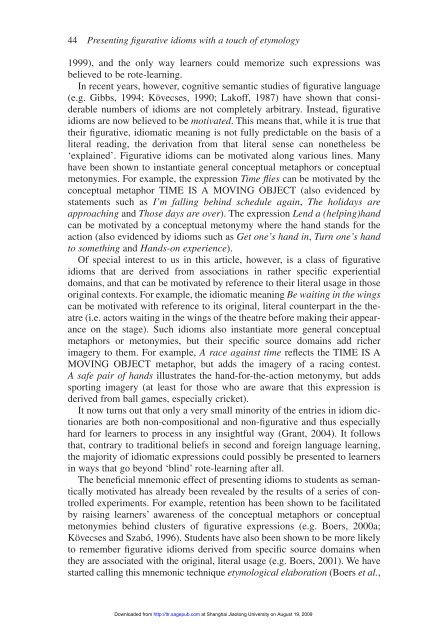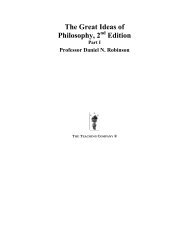Language Teaching Research
Language Teaching Research
Language Teaching Research
Create successful ePaper yourself
Turn your PDF publications into a flip-book with our unique Google optimized e-Paper software.
44 Presenting figurative idioms with a touch of etymology<br />
1999), and the only way learners could memorize such expressions was<br />
believed to be rote-learning.<br />
In recent years, however, cognitive semantic studies of figurative language<br />
(e.g. Gibbs, 1994; Kövecses, 1990; Lakoff, 1987) have shown that considerable<br />
numbers of idioms are not completely arbitrary. Instead, figurative<br />
idioms are now believed to be motivated. This means that, while it is true that<br />
their figurative, idiomatic meaning is not fully predictable on the basis of a<br />
literal reading, the derivation from that literal sense can nonetheless be<br />
‘explained’. Figurative idioms can be motivated along various lines. Many<br />
have been shown to instantiate general conceptual metaphors or conceptual<br />
metonymies. For example, the expression Time flies can be motivated by the<br />
conceptual metaphor TIME IS A MOVING OBJECT (also evidenced by<br />
statements such as I’m falling behind schedule again, The holidays are<br />
approaching and Those days are over). The expression Lend a (helping)hand<br />
can be motivated by a conceptual metonymy where the hand stands for the<br />
action (also evidenced by idioms such as Get one’s hand in, Turn one’s hand<br />
to something and Hands-on experience).<br />
Of special interest to us in this article, however, is a class of figurative<br />
idioms that are derived from associations in rather specific experiential<br />
domains, and that can be motivated by reference to their literal usage in those<br />
original contexts. For example, the idiomatic meaning Be waiting in the wings<br />
can be motivated with reference to its original, literal counterpart in the theatre<br />
(i.e. actors waiting in the wings of the theatre before making their appearance<br />
on the stage). Such idioms also instantiate more general conceptual<br />
metaphors or metonymies, but their specific source domains add richer<br />
imagery to them. For example, A race against time reflects the TIME IS A<br />
MOVING OBJECT metaphor, but adds the imagery of a racing contest.<br />
A safe pair of hands illustrates the hand-for-the-action metonymy, but adds<br />
sporting imagery (at least for those who are aware that this expression is<br />
derived from ball games, especially cricket).<br />
It now turns out that only a very small minority of the entries in idiom dictionaries<br />
are both non-compositional and non-figurative and thus especially<br />
hard for learners to process in any insightful way (Grant, 2004). It follows<br />
that, contrary to traditional beliefs in second and foreign language learning,<br />
the majority of idiomatic expressions could possibly be presented to learners<br />
in ways that go beyond ‘blind’ rote-learning after all.<br />
The beneficial mnemonic effect of presenting idioms to students as semantically<br />
motivated has already been revealed by the results of a series of controlled<br />
experiments. For example, retention has been shown to be facilitated<br />
by raising learners’ awareness of the conceptual metaphors or conceptual<br />
metonymies behind clusters of figurative expressions (e.g. Boers, 2000a;<br />
Kövecses and Szabó, 1996). Students have also been shown to be more likely<br />
to remember figurative idioms derived from specific source domains when<br />
they are associated with the original, literal usage (e.g. Boers, 2001). We have<br />
started calling this mnemonic technique etymological elaboration (Boers et al.,<br />
Downloaded from<br />
http://ltr.sagepub.com at Shanghai Jiaotong University on August 19, 2009














